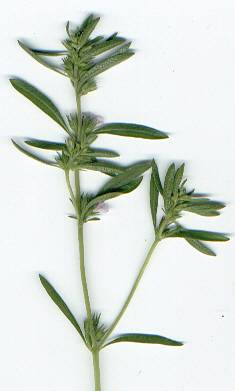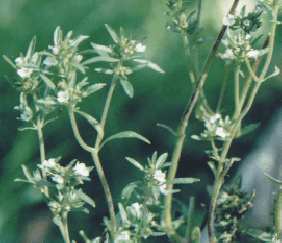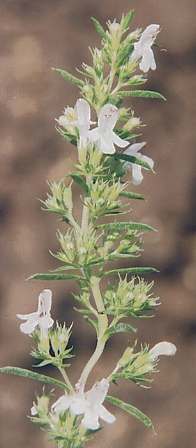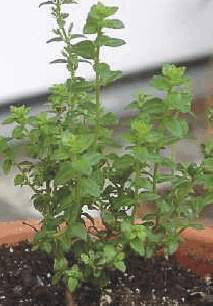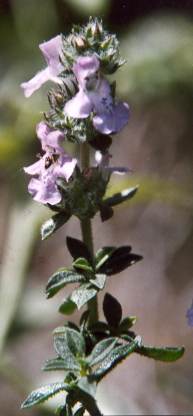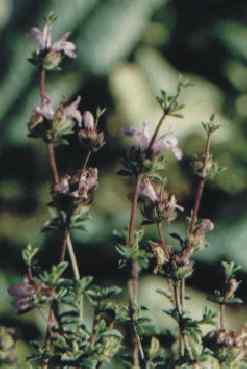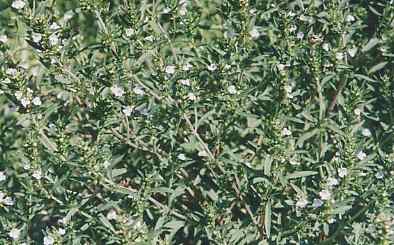
|
| Flowering savory |
Despite savory’s similarities to thyme, its applications are rather the opposite: It is rarely used for meats, but mostly for vegetables. Savory is very often employed for legumes, especially dishes prepared from dried lentils or beans, where it aids digestion significantly. Furthermore, I find it is very well suited for mushrooms. As an authentic flavouring for traditional Central European food, savory may well be combined with hyssop for rustic bean or potato recipes.
On the other hand, savory is frequently found in commercial spice mixtures for sausages, pâtés or pickles. Though not obligatory, it is often part of the Southern France spice mixture herbes de Provence (see lavender), and it is found in most versions of Georgian khmeli-suneli (see blue fenugreek). It is quite a popular culinary herb in Germany; thus, it is often employed in German versions of bouquet garni (see parsley).
Some books recommend to add savory early in the cooking process, but to my taste, savory’s aroma is diminished by long cooking, and therefore I usually add it only one or two minutes before the dish is finished.
Because of its strong affinity to legumes in general and beans in particular,
savory makes a good alternative for the herb epazote
called for in some Central American bean recipes, if the latter is
unavailable.
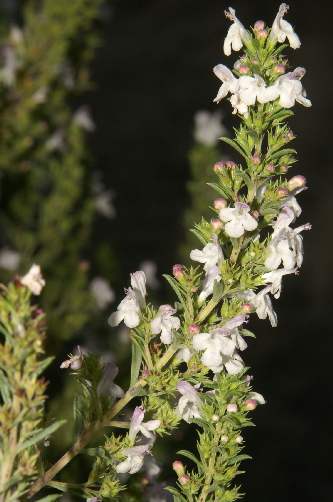
|
| Winter savory flowers |
In South Eastern Europe, from the Balkan to the Black Sea, savory has some importance as flavouring for beans, vegetables and braised foods. In Croatia, there is even a local lemon-scented variety which I like to grilled fish, even more than lemon thyme. In Bulgaria, savory (named chubritsa or more correctly čubrica [чубрица]) is the most frequently used culinary herb and is employed almost universally. Grown in the warm Bulgarian climate, savory develops a most pleasant aroma reminiscent of thyme. Note that in some Slavonic tongues, names similar to chubritsa may apply either to thyme or to savory.
Bulgarian kavurma or kavarma [кавърма] is meat (usually pork or mutton) slowly stewed in a clay pot. It contains various vegetables (onions, tomatoes, mushrooms), red or white wine and is seasoned with savory and black pepper.
The national dish of Bulgaria, sarmi [сарми]
(cabbage rolls), consists of a mixture of fried
onions, uncooked rice and ground
meat that is wrapped in cabbage leaves and slowly cooked.
Bulgarians prefer cabbage leaves that have been fermented to yield
a kind of uncut sauerkraut
and flavour the meat stuffing with
savory (besides pepper, parsley, dill and possibly
paprika). There are many similar foods
in outher South East European places, e. g., the Balkan variant sarma [сарма],
which is often cooked in tomato sauce and thus acquires a more intensive, reddish colour.
Quite often one finds spice blends named as chubritza
or tschubritsa (spoken tshubritza)
for Bulgarian or more generally Balkan cooking.
Yet in Bulgaria, that name almost always refers only to pure savory,
not to some herb mixture; the latters are often known as sharena sol [шарена сол] coloured salt
.
An alternate name is merudiya or merudia [мерудия], which usually
means parsley, but may also refer to either savory or the sharena sol mixture.
In Bulgaria, blends may contain salt, paprika, dried herbs (savory, thyme, basil, lovage) and often also either desiccated garlic or herbs with garlicky flavour like honey garlic (Nectaroscordum siculum ssp. bulgaricum syn. Allium bulgaricum) known as samardala [самардала] in Bulgarian.
In Georgia, savory is one of the most popular culinary herb. It is mostly used dry and ground, and also appears in the
spice blend khmeli-suneli (see blue fenugreek) and in the table condiment
svanuri marili (see garlic).
